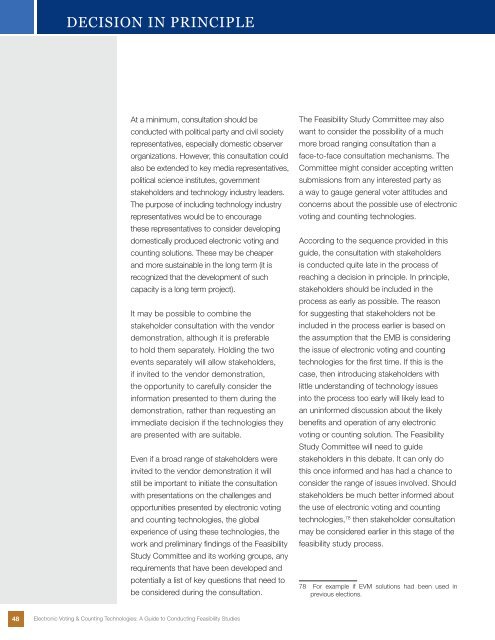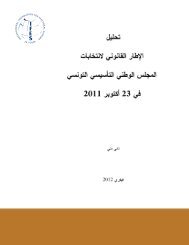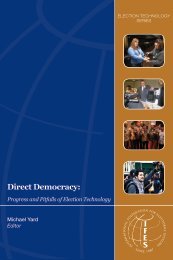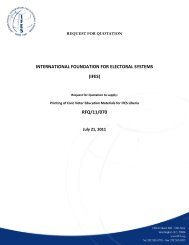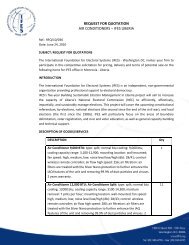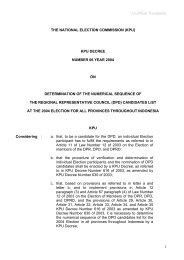Electronic Voting & Counting Technologies - IFES
Electronic Voting & Counting Technologies - IFES
Electronic Voting & Counting Technologies - IFES
- No tags were found...
Create successful ePaper yourself
Turn your PDF publications into a flip-book with our unique Google optimized e-Paper software.
INTERNATIONAL DECISION PRINCIPLEELECTORAL STANDARDSAt a minimum, consultation should beconducted with political party and civil societyrepresentatives, especially domestic observerorganizations. However, this consultation couldalso be extended to key media representatives,political science institutes, governmentstakeholders and technology industry leaders.The purpose of including technology industryrepresentatives would be to encouragethese representatives to consider developingdomestically produced electronic voting andcounting solutions. These may be cheaperand more sustainable in the long term (it isrecognized that the development of suchcapacity is a long term project).It may be possible to combine thestakeholder consultation with the vendordemonstration, although it is preferableto hold them separately. Holding the twoevents separately will allow stakeholders,if invited to the vendor demonstration,the opportunity to carefully consider theinformation presented to them during thedemonstration, rather than requesting animmediate decision if the technologies theyare presented with are suitable.Even if a broad range of stakeholders wereinvited to the vendor demonstration it willstill be important to initiate the consultationwith presentations on the challenges andopportunities presented by electronic votingand counting technologies, the globalexperience of using these technologies, thework and preliminary findings of the FeasibilityStudy Committee and its working groups, anyrequirements that have been developed andpotentially a list of key questions that need tobe considered during the consultation.The Feasibility Study Committee may alsowant to consider the possibility of a muchmore broad ranging consultation than aface-to-face consultation mechanisms. TheCommittee might consider accepting writtensubmissions from any interested party asa way to gauge general voter attitudes andconcerns about the possible use of electronicvoting and counting technologies.According to the sequence provided in thisguide, the consultation with stakeholdersis conducted quite late in the process ofreaching a decision in principle. In principle,stakeholders should be included in theprocess as early as possible. The reasonfor suggesting that stakeholders not beincluded in the process earlier is based onthe assumption that the EMB is consideringthe issue of electronic voting and countingtechnologies for the first time. If this is thecase, then introducing stakeholders withlittle understanding of technology issuesinto the process too early will likely lead toan uninformed discussion about the likelybenefits and operation of any electronicvoting or counting solution. The FeasibilityStudy Committee will need to guidestakeholders in this debate. It can only dothis once informed and has had a chance toconsider the range of issues involved. Shouldstakeholders be much better informed aboutthe use of electronic voting and countingtechnologies, 78 then stakeholder consultationmay be considered earlier in this stage of thefeasibility study process.78 For example if EVM solutions had been used inprevious elections.48<strong>Electronic</strong> <strong>Voting</strong> & <strong>Counting</strong> <strong>Technologies</strong>: A Guide to Conducting Feasibility Studies


